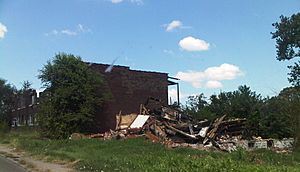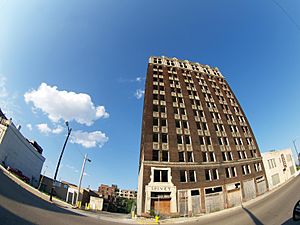East St. Louis, Illinois facts for kids
Quick facts for kids
East St. Louis, Illinois
|
|||
|---|---|---|---|
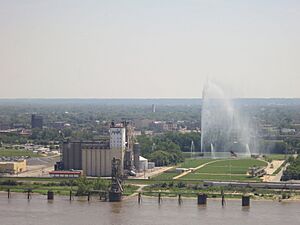
East St. Louis and the Gateway Geyser
|
|||
|
|||
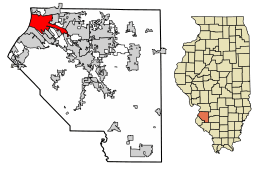
Location of East St. Louis in St. Clair County, Illinois
|
|||
| Country | |||
| State | |||
| County | St. Clair | ||
| Township | East St. Louis (coterminous) | ||
| Founded | June 6, 1820 | ||
| Incorporated | February 16, 1865 | ||
| Government | |||
| • Type | Council–manager | ||
| Area | |||
| • Total | 14.30 sq mi (37.03 km2) | ||
| • Land | 13.92 sq mi (36.05 km2) | ||
| • Water | 0.38 sq mi (0.98 km2) | ||
| Elevation | 423 ft (129 m) | ||
| Population
(2020)
|
|||
| • Total | 18,469 | ||
| • Estimate
(2023)
|
17,642 |
||
| • Density | 1,326.89/sq mi (512.33/km2) | ||
| Time zone | UTC−6 (CST) | ||
| • Summer (DST) | UTC−5 (CDT) | ||
| ZIP Codes |
62201–62207
|
||
| Area code(s) | 618 | ||
| FIPS code | 17-163-22268 | ||
| GNIS feature ID | 2394607 | ||
East St. Louis is a city in St. Clair County, Illinois, United States. It is directly across the Mississippi River from downtown St. Louis, Missouri, and the Gateway Arch National Park. East St. Louis is in the Metro East region of Southern Illinois. Once a bustling industrial center, like many cities in the Rust Belt, East St. Louis was severely affected by the loss of jobs due to the flight of the population to the suburbs during the riots of the late 1960s. In 1950, East St. Louis was the fourth-largest city in Illinois when its population peaked at 82,366. As of the 2020 census, the city had a population of 18,469, less than one-quarter of the 1950 census and a decline of almost one third since 2010.
A recent addition to the city's waterfront is the Gateway Geyser. On the grounds of Malcolm W. Martin Memorial Park, the fountain is the second-tallest in the world. Designed to complement the Gateway Arch across the river in St. Louis, it shoots water to a height of 630 feet (190 m), the same height as the arch.
Contents
History
Native Americans had long inhabited both sides of the Mississippi River. The Mississippian culture rulers organized thousands of workers to construct complex earthwork mounds at what later became St. Louis and East St. Louis. The center of this culture was the urban complex of Cahokia, located to the north of present-day East St. Louis within Collinsville, Illinois. Before the Civil War, settlers reported up to 50 mounds in the area that became East St. Louis, but most were lost to 19th-century development and later roadbuilding.
East St. Louis lies within the fertile American Bottom area of the present day Metro-East area of St. Louis, Missouri. This name was given after the United States acquired the Louisiana Purchase in 1803, and more European Americans began to settle in the area. The village was first named "Illinoistown".
East St. Louis was founded in 1797 by Captain James Piggott, a Revolutionary War veteran. In that year Piggott began operating a ferry service across the Mississippi River, connecting Illinoistown with St. Louis, which had been founded by ethnic French families. When Piggott died in 1799, his widow sold the ferry business, moved to St. Louis County and remarried. One of the Piggotts' great-great-granddaughters became known as actress Virginia Mayo (Virginia Clara Jones).
The municipality called East St. Louis was established on April 1, 1861. Illinoistown residents voted on a new name that day, and 183 voted to rename the town East St. Louis. Though it started as a small town, East St. Louis soon grew to a larger city, influenced by the growing economy of St. Louis, which in 1870 was the fourth-largest city in the United States.
Great Railroad Strike of 1877
A period of extensive industrial growth followed the American Civil War. Industries in East St. Louis made use of the local availability of Illinois coal as fuel. Another early industry was meatpacking and stockyards, concentrated in one area to limit their nuisance to other jurisdictions.
In the expansion, many businessmen became overextended in credit, and a major economic collapse followed the Panic of 1873. This was due to railroad and other manufacturing expansion, land speculation, and general business optimism caused by large profits from inflation. The economic recession began in the East and steadily moved West, severely crippling the railroads, the main system of transportation. In response, railroad companies began dramatically lowering workers' wages, forcing employees to work without pay, and cutting jobs and paid work hours. These wage cuts and additional money-saving tactics prompted strikes and massive unrest.
While most of the strikes in the eastern cities during 1877 were accompanied by violence, the late July 1877 St. Louis strike was marked by a bloodless and quick takeover by dissatisfied workers. By July 22, the St. Louis Commune began to take shape, as representatives from almost all the railroad lines met in East St. Louis. They soon elected an executive committee to command the strike and issued General Order No. 1, halting all railroad traffic other than passenger and mail trains. John Bowman, the mayor of East St. Louis, was appointed arbitrator of the committee. He helped the committee select special police to guard the property of the railroads from damage. The strike and the new de facto workers' government, while given encouragement by the largely German-American Workingmen's Party and the Knights of Labor (two key players in the organization of the Missouri general strike), were run by no organized labor group.
The strike also closed packing industry houses surrounding the National Stock Yards. At one plant, workers allowed processing of 125 cattle in return for 500 cans of beef for the workers. Though the East St. Louis strike continued in an orderly fashion, across the river in St. Louis there were isolated incidents of violence.
The strikers held the railroads and city for about a week, without the violence that took place in Chicago and other cities. The federal government intervened, and on July 28 US troops took over the Relay Depot, the Commune's command center, and the strike ended peacefully.
Great Cyclone of 1896
On May 27, 1896, a tornado struck St. Louis and East St. Louis. It stands as the deadliest tornado to ever hit the cities. In approximately 20 minutes, this tornado resulted in destruction that killed 137 people in St. Louis and 118 in East St. Louis. The tornado's destruction spanned 10 miles (16 km), including the railyards and commercial districts of East St. Louis. During the storm, 311 buildings were destroyed and 7,200 others were severely damaged. The cost of this loss was estimated to be between $10 million and $12 million. In 1896 this was a considerable amount of money, as a two-story brick house could be purchased at that time for $1,500.
East St. Louis riots of 1917
East St. Louis in 1917 had a strong industrial economy boosted by America's economic participation in demands related to World War I; although war was declared in April, the nation did not meaningfully enter the war until that fall. Industry was dominated by European immigrant workers, who had been coming to industrial cities since the late 19th century. Here and across the country, they repeatedly tried to organize in efforts to gain better wages and working conditions. In the summer of 1916, 2,500 white workers struck the nearby meat packing plants of National City. Companies recruited black workers, sometimes importing them from the South. While the white workers won a wage increase, the companies retained some black workers, firing white ones. Such economic competition raised tensions between the groups in a period when the number of blacks in East St. Louis had increased dramatically due to the first Great Migration, when African Americans left poor rural areas of the South to escape Jim Crow oppression and seek jobs in the industrial cities of the North and the Midwest. From 1910 to 1917, the black population nearly doubled in East St. Louis.
The United States established a draft which would bring in many workers to the military. As the war prevented immigration from Europe even before the U.S. entered the war, major companies had begun to recruit black workers from the South to fill demand. When white workers went on strike in April 1917 at the Aluminum Ore Company, the employer hired blacks as strikebreakers. The American Steel Company also recruited blacks. They were available in part during this period because the U.S. Army initially rejected many black volunteers in the years before an integrated military. This was also the period of resentment on both sides and the arrival of new workers created fears for job security at a time of union organizing and labor unrest, and raised social tensions. At a large labor meeting of white workers held in City Hall on May 28, men also traded rumors of fraternizing between black men and white women. An inflammatory speaker said, "East St. Louis must remain a white man's town." Three thousand ethnic white men left the meeting and headed as a mob for downtown, where they randomly attacked black men on the street. The Illinois governor called in National Guard to prevent further rioting, but rumors circulated that blacks were planning an organized retaliation and tensions remained high.
Though official reports suggested that the East St. Louis race riot resulted in the deaths of 39 blacks and 9 whites, other estimates put the figure much higher.
W. E. B. Du Bois of the NAACP came to investigate the riots personally. His organization's photographer published photos of the destruction in the November issue of The Crisis. Congress also held an investigation.
In New York City on July 28, 10,000 black people marched down Fifth Avenue in a Silent Parade, carrying signs and protesting the East St. Louis riots. The march was organized by the National Association for the Advancement of Colored People (NAACP), W. E. B. Du Bois, and groups in Harlem. Women and children were dressed in white; the men were dressed in black.
20th century
East St. Louis continued to have an economy based on industry. Through and after World War II, many workers could make decent livings. It was named an All-America City in 1959 by the National Civic League. East St. Louis celebrated its centennial in 1961. It was known as the "Pittsburgh of the West". Its population had reached a peak of 82,366 residents in the 1950 census, the fourth-largest city in Illinois at the time.
Through the 1950s and later, the city's musicians were an integral creative force in blues, rock and roll and jazz. Some left and achieved national recognition, such as Ike & Tina Turner. The jazz great Miles Davis, who became internationally known, was born in nearby Alton and grew up in East St. Louis. The 1999 PBS series River of Song featured these musicians in its coverage of music from cities along the Mississippi River.
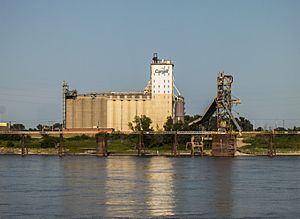
The city suffered from the mid-century restructuring of heavy industry and railroads, which cost widespread loss of jobs. As a number of local factories began to close because of changes in industry, the railroad and meatpacking industries also were cutting back and moving jobs out of the region. This led to a precipitous loss of working and middle-class jobs. The city's financial conditions deteriorated. Elected in 1951, Mayor Alvin Fields tried funding measures that resulted in raising the city's bonded indebtedness and the property tax rate. More businesses closed as workers left the area to seek jobs in other regions. The more established white workers had an easier time gaining jobs in other localities, and the city population became increasingly black. "Brownfields" (areas with environmental contamination by heavy industry) have made redevelopment more difficult and expensive.
Street gangs appeared in city neighborhoods. Like other cities with endemic problems by the 1960s, violence added to residential mistrust and adversely affected the downtown retail base and the city's income.
The construction of freeways also contributed to East St. Louis' decline. They were constructed through and broke up functioning neighborhoods and community networks, adding to the social disruption of the period. The freeways made it easier for residents to commute back and forth from suburban homes, so the wealthier people moved out to newer housing. East St. Louis adopted a number of programs to try to reverse decline: the Model Cities program, the Concentrated Employment Program, and Operation Breakthrough. The programs were not enough to offset the loss of industrial jobs due to national restructuring.
In 1971, James E. Williams was elected as the city's first black mayor. Faced with the overwhelming economic problems, he was unable to make much of a difference. In 1975, William E. Mason was elected mayor; his term marked a return to patronage politics and the city sank deeper into debt and reliance on federal funding. In 1979, Carl Officer was elected as mayor (the youngest in the country at that time, at age 25). Despite hopes for improvement, conditions continued to decline. Middle-class citizens continued to leave the city. People who could get jobs moved to places with work and a decent quality of life. Lacking sufficient tax revenues, the city cut back on maintenance, sewers failed, and garbage pickup ceased. Police cars and radios stopped working. The East St. Louis Fire Department went on strike in the 1970s.
Structure fires destroyed such a significant number of consecutive blocks that much of the post-Armageddon film Escape from New York was filmed in East St. Louis.
In 1990, the State of Illinois passed (65 ILCS 5/Art. 8 Div. 12) The Financially Distressed City Law. Under this law, Illinois Governor James R. Thompson provided $34 million in loans to East St. Louis, with the stipulation that an appointed five-member board, called the East St. Louis Financial Advisory Authority, manage the city's finances. In 1990 the state legislature approved riverboat gambling in an effort to increase state revenues. The opening of the Casino Queen riverboat casino generated the first new source of income for the city in nearly 30 years.
In 1991, Gordon Bush was elected mayor. Several major industries operating in the area had gained separate incorporation as jurisdictions for the land where their plants are sited. These "communities" have virtually no residents, and the shell jurisdictions are outside the tax base of East St. Louis. Residents of the city, however, suffer from contaminated air and other adverse environmental effects of these sites. At the same time, the city's tax base is too poor for it to maintain its infrastructure, including the sanitary sewers, many of which have broken and overflowed in residential neighborhoods and schools.
21st century
Since 2000, the city has completed several redevelopment projects: in 2001 it opened a new library and built a new city hall. Public-private partnerships have resulted in a variety of new retail developments, and housing initiatives. The St. Louis MetroLink light rail connects the city by transit to St. Louis, which has a stronger economy, and such efforts have sparked renewal.
Because of depopulation, the city has many abandoned properties and extensive urban blight. Sections of "urban prairie" can be found where vacant buildings were demolished and whole blocks have become overgrown with vegetation. Much of the territory surrounding the city remains undeveloped, bypassed by developers who chose more affluent suburban areas. Many old "inner city" neighborhoods abut large swaths of corn and soybean fields or otherwise vacant land. In addition to agricultural uses, a number of truck stops and semi-rural businesses surround blighted areas in the city.
In 2010, the East St. Louis community gardening movement began to develop plots for "urban farming", as has been done in North St. Louis. Inspired by Detroit's planned use of vacant land for green development, community associations, nonprofits and universities have collaborated to spark green development in East St. Louis.
Archeological remains
In the early 1990s, archeological surveys and excavations prior to construction of Interstate 55/70 revealed evidence of important prehistoric structures in the East St. Louis area. Both sides of the river had earlier been reported as having numerous earthwork mounds when Europeans and Americans first settled in the area. Unfortunately, most of these cultural treasures in St. Louis and on the east side were lost to development.
Illinois researchers discovered the remains of several earthwork mounds. In the East St. Louis area, 50 mounds had been mapped before the Civil War, and seven remain visible today. The largest is estimated to have been originally 40 feet (12 m) high and would have nearly covered a football field. Around the remains of this mound, researchers have discovered evidence of burial mounds, a large plaza, a wooden defensive palisade and several other Mississippian culture structures. These indicate that it was a ritual center. The 500-acre (200 ha) prehistoric site is now called the East St. Louis Mound Center. The state and University of Illinois are trying to develop coordinated projects with East St. Louis and businesses to use the mounds and artifacts as attractions for heritage tourism.
It was built by the Mississippian culture, which extended throughout the Ohio and Mississippi valleys. It reached its peak in this region about AD 1100–1200 at the nearby major center of Cahokia, a designated UNESCO World Heritage Site within the present-day boundaries of Collinsville. A complex urban center estimated to have had a population of perhaps 20,000, this site is about 5 miles (8 km) from East St. Louis.
In 2012, archeological work prior to construction of the Stan Musial Bridge across the Mississippi discovered artifacts and evidence of a formerly unidentified 900-year-old suburb of Cahokia in present-day East St. Louis. This site had not been mapped in the 19th century, and was unknown. The Mississippian culture site is in a present industrial wasteland. Researchers found evidence of more than 1,000 dwellings and the base of an earthen pyramidal mound. It would have been one of dozens of mounds when the community was active, based on the size of the residential population of this site. Discovery of the site led scholars to increase their estimates of the total population of the Mississippians at Cahokia and in the area, now thought to have been about 20,000. They did not have the time to excavate the entire area. It is on private land and subject to risk of destruction by development.
Geography
East St. Louis is located at 38°37′N 90°8′W / 38.617°N 90.133°W (38.616, −90.133).
According to the 2010 census, East St. Louis has a total area of 14.37 square miles (37.22 km2), of which 13.99 square miles (36.23 km2), or 97.36%, is land and 0.38 square miles (0.98 km2), or 2.64%, is water.
Climate
East St. Louis, like all of Southern Illinois, is classified as humid subtropical by the Köppen classification, having hot, humid summers and cool winters. On July 14, 1954, the temperature in East St. Louis allegedly reached 117 °F (47 °C), the highest temperature ever recorded in America east of the Mississippi River. It is not considered a formal record, however, as the city had no weather station.
Transportation
East St. Louis has five St. Louis MetroLink stations: East Riverfront, 5th & Missouri, Emerson Park, JJK Center, and Washington Park.
Interstate 55, Interstate 64, Interstate 70, and U.S. Route 40 run through East St. Louis and are linked to St. Louis by the Poplar Street Bridge and Stan Musial Bridge. Prior to its decommissioning, the fabled U.S. Route 66 also shared a concurrency with these Interstate highways. In addition, U.S. Route 50 also shared a concurrency prior to its being rerouted to run concurrently with Interstate 255.
The closest airport is the St. Louis Downtown Airport located in nearby Cahokia, Illinois, just south of East St. Louis.

Demographics
| Historical population | |||
|---|---|---|---|
| Census | Pop. | %± | |
| 1870 | 5,044 | — | |
| 1880 | 9,185 | 82.1% | |
| 1890 | 15,169 | 65.1% | |
| 1900 | 29,734 | 96.0% | |
| 1910 | 58,540 | 96.9% | |
| 1920 | 66,785 | 14.1% | |
| 1930 | 74,397 | 11.4% | |
| 1940 | 75,603 | 1.6% | |
| 1950 | 82,366 | 8.9% | |
| 1960 | 81,728 | −0.8% | |
| 1970 | 70,029 | −14.3% | |
| 1980 | 55,239 | −21.1% | |
| 1990 | 40,944 | −25.9% | |
| 2000 | 31,542 | −23.0% | |
| 2010 | 27,006 | −14.4% | |
| 2020 | 18,469 | −31.6% | |
| 2023 (est.) | 17,642 | −34.7% | |
| U.S. Decennial Census 2010 2020 |
|||
2020 census
| Race / Ethnicity (NH = Non-Hispanic) | Pop 1990 | Pop 2000 | Pop 2010 | Pop 2020 | % 1990 | % 2000 | % 2010 | % 2020 |
|---|---|---|---|---|---|---|---|---|
| White alone (NH) | 641 | 363 | 219 | 222 | 1.57% | 1.15% | 0.81% | 1.20% |
| Black or African American alone (NH) | 40,061 | 30,702 | 26,378 | 17,536 | 97.84% | 97.34% | 97.67% | 94.95% |
| Native American or Alaska Native alone (NH) | 46 | 49 | 22 | 30 | 0.11% | 0.16% | 0.08% | 0.16% |
| Asian alone (NH) | 21 | 24 | 24 | 15 | 0.05% | 0.08% | 0.09% | 0.08% |
| Pacific Islander alone (NH) | N/A | 9 | 3 | 3 | N/A | 0.03% | 0.01% | 0.02% |
| Some Other Race alone (NH) | 16 | 10 | 19 | 52 | 0.04% | 0.03% | 0.07% | 0.28% |
| Mixed Race or Multi-Racial (NH) | N/A | 155 | 208 | 442 | N/A | 0.49% | 0.77% | 2.39% |
| Hispanic or Latino (any race) | 159 | 230 | 133 | 169 | 0.39% | 0.73% | 0.49% | 0.92% |
| Total | 40,944 | 31,542 | 27,006 | 18,469 | 100.00% | 100.00% | 100.00% | 100.00% |
Education
The city is served by the East St. Louis School District 189. As of 2017, the district operates an early childhood learning center, 5 elementary schools, 2 middle schools, and one high school, East St. Louis High School. Until 1998, East St. Louis Lincoln High School also served portions of the city.
There are two private K–8 schools in East St. Louis: Sister Thea Bowman Catholic School and Unity Lutheran Christian Elementary School. Sister Thea Bowman Catholic School is operated under the Roman Catholic Diocese of Belleville. There were previously four Catholic elementary schools: St. Joseph, St. Martin of Tours, St. Patrick, St. Philip, Holy Angels and St. Adalbert. In 1989 they consolidated at the St. Philip location as Bowman.
Starting in 1894, St. Teresa Academy was established by the Sisters of the Most Precious Blood, as a high school for young women. The school closed in 1974.
In 1929 Central Catholic High School for Boys was established with the name being changed to Assumption High School in 1953. Women were welcomed to Assumption in 1974 after St. Teresa Academy closed. Later, Assumption closed in 1989.
Notable people
Media
One television station is licensed to, but does not operate from, the city: Ion Television affiliate WRBU (Channel 46), which serves the entire St. Louis market. In the past, it served as St. Louis's UPN and MyNetworkTV affiliate. On FM, sports station WXOS (101.1) and non-commercial Contemporary Christian music station WCBW (89.7) are licensed to East St. Louis.
The Metro-East Journal, originally the East St. Louis Journal, was published in the city from 1888 to 1979. The East St. Louis Monitor was a newspaper published from 1963 to 2024.
See also
 In Spanish: San Luis Este para niños
In Spanish: San Luis Este para niños




